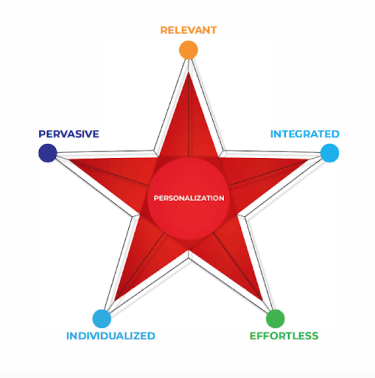Ecommerce personalization has become the north star for customer-centric companies.
Why? The reason is simple – personalized digital experiences engender greater emotional engagement by showing customers more of what they want, when they need it. This has a positive effect on the conversion rate of ecommerce sites and also boosts loyalty and customer lifetime value. With 78% of US online adults having chosen, recommended, or paid more for a brand using personalized digital experiences or services, the personalization payoff is clear.
However, many companies are still lagging behind, despite being aware of the power of personalization. Many commerce players still haven’t even taken the first step of defining what “personalization” means to their customers and businesses. Several of them actually think they can check the box on personalization just because they greet the customer by name. Gestures like these are nothing more than empty acts that provide no value to customers. Personalization done wrong can also have damaging effects, costing US firms $756 billion and a total of $2.5 trillion globally.
Companies need a digital strategy that puts customers at the center in order to drive the innovation and personalization that customers value. Therefore, it is necessary to discuss the five fundamentals of best-in-class personalization that companies must champion in order to provide the best customer experiences. Personalization must be (1) relevant, (2) pervasive, (3) individualized, (4) effortless, and (5) integrated. In assessing their efforts across all areas, organizations can determine their personalization maturity as well as evaluate how they perform against their peers.

1) It must be relevant.
Personalized experiences have to be relevant to your customers. For example, imagine that one of your site visitors keeps seeing recommendations for Apple keyboards just because they purchased one a few weeks ago. A smart store clerk who is aware of the previous purchase would know there is a high likelihood that this customer would not be looking to buy another keyboard. Additionally, they might be able to determine that a customer would instead be more interested in other Apple products to combine with their previous purchase. Online retailers must keep interactions like these in mind when recommending products on their websites.
If you are comparing your website to a competitor in terms of personalization, you can start by looking at the kinds of inferences your personalization capabilities can support. Whether a customer in a B2C or B2B Commerce environment is actively looking for information or merely discovering new content, leveraging digital technology advancements to deliver a personalized customer experience adds value only if these efforts lead to providing relevant content to the user.
2) It must be pervasive.
Personalization is not something you can sprinkle here and there on your website. Doing so would leave the customer journey and experience fractured. Personalization should instead be an “all-in” endeavor – it needs to be applied everywhere.
The search box is a great place to start. Autocomplete suggestions tailored to individual visitors help them use correct terminology, avoid typos and initially refine their search. It can also be applied to results pages in order to reflect customers’ preferences and needs.
There are other elements where personalization can enter to truly elevate the experience. On-site navigation is a case in point. Shoppers can be provided with personalized facets to narrow the results using the most relevant filters. Recommendations are probably the hallmark of personalization and can inspire visitors by providing them with access to highly tailored content and products based on their preferences.
Clearly, other elements of the customer shopping experience can be personalized as well and shouldn’t be forgotten. For instance, personalized pricing enables ecommerce players to target unique consumers with unique price points. It can take a number of unique factors into account for each consumer, such as shopping and browsing history, hobbies and interests, brand loyalty – and their willingness to pay.
While personalization typically drives revenue by improving the experience for the customer, personalized pricing takes a different route. It focuses on leveraging that willingness to pay. In B2B Commerce, the adoption of personalized pricing is in fact already at an advanced stage, leveraging the same the price optimization algorithms that enabled dynamic pricing.
While beneficial, personalized pricing does have the potential to produce tension between organizations and customers’ interests. Whether personalized pricing really becomes a successful model in ecommerce will obviously be up to consumers: will shoppers be comfortable knowing that the prices they are offered may be higher than those presented to others? My advice is to be careful and watch how this trend unfolds.
3) It must be individualized.
For a personalization strategy to be successful, companies must go beyond traditional demographic-based segmentation. Instead they must stitch together a dynamic customer profile using demographics and in-context data collected across channels and sessions in order to personalize products, content and experiences. If your website’s users have shopping experiences only based on geographic location, IP address or time of visit, then you are most likely still thinking in terms of segmentation rather than personalization.
Traditional segmentation relies on single data points, such as location, age, gender, past purchase history. These point to the customer’s past, rather than current intent or need. That sweater your customer looked at on your website last week? Simple segmentation won’t tell you that she then went to your store and bought a different one. It also won’t tell you that your retargeting ads for that first sweater are not only annoying but also irrelevant because finding a sweater is not on her to-do list anymore.
Only by moving beyond segmentation it is possible to deliver unique digital experiences that are highly meaningful. In a 1998 interview with The Washington Post, Jeff Bezos stated that “if we have 4.5 million customers, we shouldn’t have one store. We should have 4.5 million stores.” Tailoring content at this individual level is a key aspect of personalization.
Considering Amazon’s AI-powered recommendations engine generates 35% of the company’s revenue, this technology is the way forward. This doesn’t just apply to the B2C Commerce space. B2B buyers also expect individualized and granular experiences that are not only company specific but also in accordance with their individual role and business needs.
4) It must be effortless.
Digital businesses also need to understand that personalization is fundamentally about delivering effortless experiences. The rise of digital channels reduced friction in the customer experience by eliminating the need for them to visit brick-and-mortar stores or have their sales rep meet them on-site to make a purchase. Now, customers can easily order products from their internet-connected devices.
However, the rise of digital channels has also reshaped the search process, increasing the amount of information available. While this can be helpful, it also produces a lot of noise and may actually prevent shoppers from completing the purchase. Search results shouldn’t make it difficult for customers to find what they want, when they want it.
Personalization uses customer data to cut through the noise, providing tailored facets and filters that increase relevance and expedite customer access to desired functionality and content. At best, legacy search solutions provide passive filters, facets and sorting. These tools and age-old methods actually make things more difficult, placing the onus on customers to find what is most relevant to them.
5) It must be integrated.
Finally, personalized digital experiences should take advantage of all the customer data that is available. Siloed touchpoints must be transformed into a seamless experience. In addition to being applied everywhere, it must connect everything.
Imagine a first-time customer making a purchase on your website or mobile app. The next time they check in on your mobile app to review the shipment, you seize the cross-sell moment by leveraging her purchase history to automatically generate personalized product recommendations. The customer adds the cross-sell product to the cart, but does not complete the purchase. This data is stored in the customer record.
Later, when the customer happens to pass by your store, personalized promotions or digital content prompted by geotargeting motivate her to step in and make that purchase immediately. For most companies, this scenario is simply impossible, as their legacy search technology does not support omnichannel personalization capabilities and leaves information siloed in disparate sources. In the omnichannel era, connected consumers and the possibility of using many different types of data allow one to harvest previously untapped opportunities.
Abiding by these fundamentals of personalization has become essential to developing and maintaining competitive advantage. While no company will rip and replace their personalization strategy or technology overnight, it has become imperative for them to take stock of their current practices to uncover their strengths and weaknesses, determine whether their personalization capabilities are lacking or imbalanced, and evolve their personalization strategy with the help of AI.
Dig Deeper
To learn more about what personalization is, what it looks like in Ecommerce, and how you can do it (successfully) without massive amounts of data, be sure to read our blog post: Powerful Personalization in Ecommerce – No Big Data Required.
And be sure to discover more about what you can do with AI-Powered Ecommerce.



